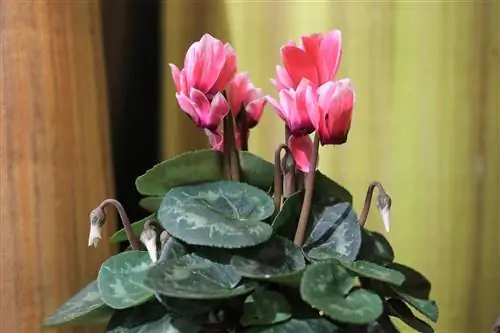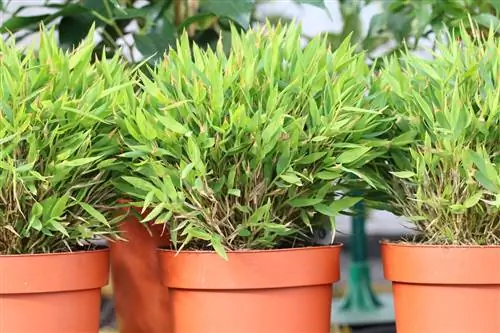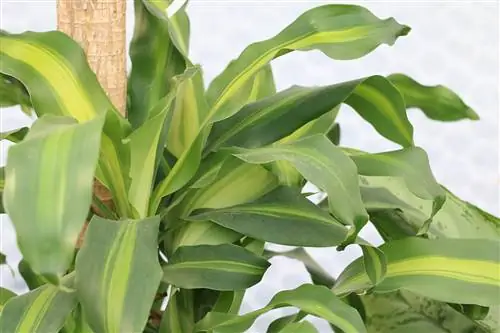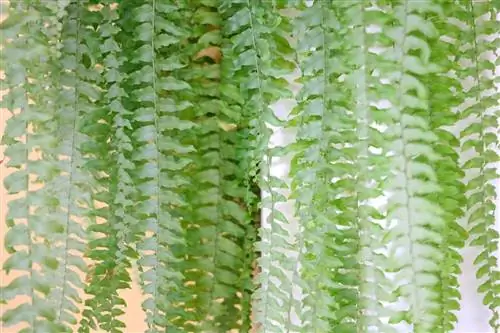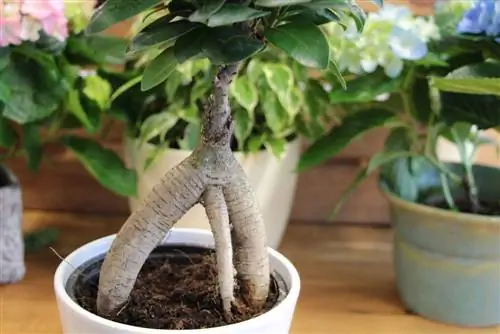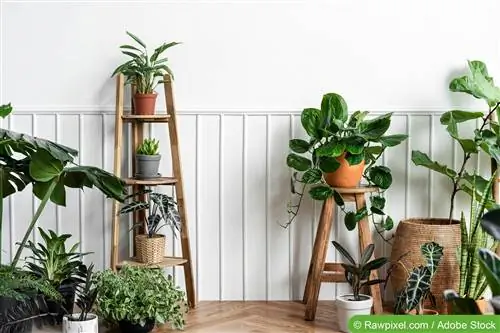- Author admin [email protected].
- Public 2023-12-17 03:39.
- Last modified 2025-01-24 12:45.
For many years, cultivated cyclamens were one of the most popular potted plants in the winter months and were therefore often given as gifts. Known to most people primarily from their grandmothers, these plants have become modern again through the breeding of new and fresh flower colors.
Incredible that this widespread plant, which comes from the Mediterranean region and the name is Persian, was once called “pork bread” in the Middle Ages. She owes this rude name to actual pigs. These had eaten their fill of the tubers in the wild. Today the wild cyclamen are protected and have become rare.
Flowers
The indoor cyclamen offers a multi-layered splendor of color with flowers on an elegantly curved flower neck. Starting with classic white flowers, through pink, pink, violet to a really strong red, all shades are available. Breeds that have two-tone flowers are now also available. The petals are either completely smooth, slightly wavy or even frayed. The size can also vary, starting with a mini cultivation up to a height of 30 cm. Many varieties also exude their typical and fine scent.
Location
The cyclamen likes it bright and cool (below 20 °C). Direct sunlight should be avoided. A medium humidity range would be ideal. Locations that are particularly suitable are:
- the kitchen area
- cold or cool winter garden
- Staircases with large skylights
- classic flower windows (without heating underneath)
- cool bedrooms
- brightly lit floors without underfloor heating
Pouring
The thumb test can be used to determine whether the soil feels dry and warm or slightly moist and cool. If it is cool, wait a little longer before watering. The cyclamen should not dry out completely - if this happens, the tuber usually dies. That's why regular checks are important. Particular care must be taken to never water directly onto the tuber, otherwise there is a risk of rot. Cyclamen are best watered either by “dipping” the ball or via the planter. Stale water at room temperature is particularly suitable. Check again 15 minutes after watering and throw away everything that is still in the planter. Waterlogging should also be avoided due to the risk of rot.
But the plant needs surprisingly little water. Only if certain conditions are met could more demand arise:
- a lush splendor of leaves and flowers
- drier and warmer air
- persistent draft, or in the wind on the sheltered terrace
- increased sunlight
Fertilize
During the flowering or growth period, the plant must be regularly supplied with flowering plant fertilizer every two weeks. After the flowering period, around April/May, fertilization is completely stopped and only resumed in autumn.
Care tips
When purchasing, make sure that they are strong plants with a large number of buds. The leaves should be firm and not discolored. At home, cyclamen stay beautiful longer if they are cleaned regularly. All withered flowers and leaves are removed for this purpose. In terms of handling, it is easiest if you hold the ball with one hand and use the other hand to remove the dead or withered parts of the plant with a vigorous tug, rather than cutting them away. Seeds that have formed and appear spherical at the end of the flower stalk should also be removed. The plant quickly compensates for any gaps that arise.
- If there is a lack of humidity, the plant should under no circumstances be sprayed! This causes more harm than good.
- Repotting is usually not possible. If so, then the time is right after flowering.
Cyclamens are occasionally attacked by mites. It can be recognized by leaves that are too small, curls and stunting. In addition, the leaf edges are curled. Too high humidity could be the cause. There are appropriate insecticide sticks to add to the potting soil.
A second danger is cyclamen wilt. Caused by a fungus in the soil, the leaves wilt and after a while the plant dies. There is no effective antidote. One way to prevent this disease is to always only use new clay pots and fresh soil for the cyclamen.
Perennial husbandry
If the joy of this plant, especially its lush flowers, lasts for several years, then this requires a little more effort. The plant is best planted outdoors in its clay pot in spring, when temperatures below 0 °C are no longer expected. The location there should be shady and cool. Around June the cyclamen begins to yellow, watering is then severely restricted and then finally stopped completely. The leaves are then completely removed. In early autumn, when the plant begins to sprout again, the clay pot is dug up again, filled with new soil and placed in a cool place in the home. Moderate and controlled watering is recommended until strong leaves develop again.
Propagate
The cyclamen are propagated by dividing the tuber or by sowing. Depending on the variety, there are two different methods via the daughter tubers, tuber formation on the stem or tuber formation at the end of a root. Another option is to cut the whole tuber. It is important to ensure that there is one shoot bud in each case. The big danger here is rot again! This could be counteracted by using sulfur powder.
What you should know about cyclamen in brief
The cyclamen is a very demanding houseplant that, with appropriate care, gives its owner a colorful display of flowers every year. The plants have circular tubers. About 15 species grow in the mountains of southern Europe, in the Mediterranean region, in the Caucasus and in Asia Minor. They are tuberous perennials. Its leaves are heart-shaped, egg-shaped or kidney-shaped, entire or bay-shaped with a toothed-serrated edge. The flower stalk bears a nodding flower with petals folded back upwards. The multi-seeded fruit capsule has a straight or spirally twisted stem.
Tip: The cyclamen are particularly effective when combined with other colored conspecifics. The particularly large varieties are also suitable as cut flowers, although the term cut flower is not entirely appropriate as the individual flowers should not be cut off but rather plucked off.
- Cyclamens are grateful and long-flowering houseplants.
- Especially suitable for double windows or rooms that are not heated or not very heated.
- A location on the window sill above radiators is unsuitable.
- Cyclamens love a bright, cool and airy location.
- The temperatures should be between 10 and 15°C and, if possible, not rise above 18°C for a long period of time.
- Watering is done so that the soil is always evenly moist.
- Congested moisture, as well as severe drying out, is not tolerated.
- In winter, the tuber must not be watered when it is cool, otherwise the buds and leaf or flower stalks will rot.
- Standing water in the base leads to root rot.
- Leaf soil with peat, compost or a little clay or garden soil and sand, including standard soil, is suitable as a substrate;
- PH value around 6. Transplanted annually in August. The used soil is shaken out.
- When planting, make sure that the tuber protrudes about 1/3 from the soil; only for seedlings is it covered with soil.
Cyclamens are usually bought in bloom. However, they are easy to get to bloom again and again for many years. They continue to be watered throughout the summer. If fertilized weekly they will retain their leaves. The plants can also go through a resting period in summer, during this time they are only moderately moist and usually lose their leaves. They can also be kept in partial shade on the balcony over the summer or planted in pots in the garden. The new growing season begins with transplanting in August. Perennial cyclamen bloom later, i.e. usually at the beginning of the new year, but much more abundantly. During the growing season from September/October, fertilization should be carried out weekly after good root penetration.

